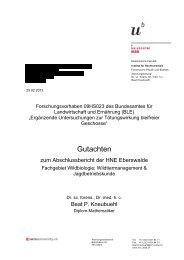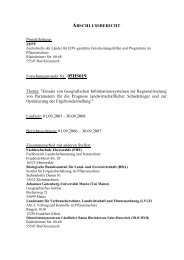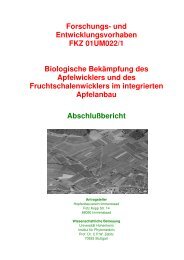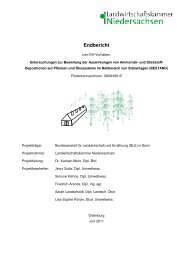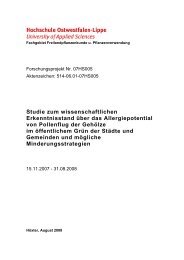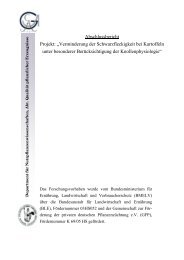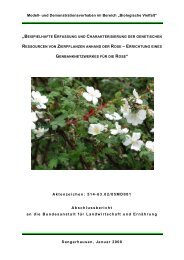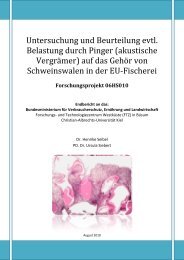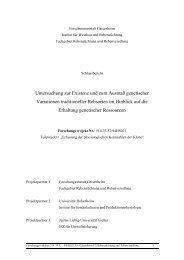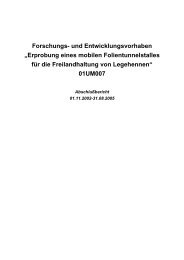Projekt 05HS022 Identifizierung und Vermeidung der hot ... - BLE
Projekt 05HS022 Identifizierung und Vermeidung der hot ... - BLE
Projekt 05HS022 Identifizierung und Vermeidung der hot ... - BLE
Erfolgreiche ePaper selbst erstellen
Machen Sie aus Ihren PDF Publikationen ein blätterbares Flipbook mit unserer einzigartigen Google optimierten e-Paper Software.
0. Extended Summary<br />
16 g per sprayer in 2007. This is about 4.6 g (2006) and 2.6 g (2007) per hectare vineyard<br />
area. Substances with the highest loads were fenhexamide, pyrimethanil, boscalide, tebuconazole,<br />
cyprodinil <strong>und</strong> fludioxinil. The highest loads correspond to the combat of the fungi<br />
Botrytis cinerea, Plasmopara viticola and Oidium. Therefore the different results between the<br />
two years can be explained with the different infection pressure and the different treatment<br />
frequencies.<br />
Results of the arable farming sewage treatment plants<br />
The most remarkable result for the arable farming STPs is the extremely high variability between<br />
the singe STPs. Absolute pesticide loads vary between 140 g and 35000 g per study<br />
period, the main emission period was during the cropping season in spring. Calculated pesticide<br />
loads per sprayer were about 40 g in average (seven STPs) during the first sampling period<br />
(25 compo<strong>und</strong>s, two metabolites). Detailed results show however a high variability from<br />
about 2 g up to 120 g per sprayer (the two STPs with minimum and maximum loads per<br />
sprayer during one sampling period). The pesticide loss per treated area was between 0.02 g<br />
and 1.8 g per hectare.<br />
Much higher loads per sprayer were detected during the sampling of the three arable farming<br />
STPs in Autumn 2007 and spring 2008. Maximum load was 445 g per sprayer, a value never<br />
reported in the literature so far. Extremely high temporal <strong>und</strong> regional variability is evidently<br />
characteristic for pesticide losses from farmyards.<br />
These eleven compo<strong>und</strong>s contributed approximately 80 % of the total load (with seasonal<br />
variability): metamitron (incl. desamino-metamitron), isoproturon, MCPA, 2,4-DP (a.k.a.<br />
dichlorprop), ethofumesate, tebuconazole, MCPP (a.k.a. mecoprop), metazachlor, epoxiconazole,<br />
terbuthylazine, and bentazone. This or<strong>der</strong> of compo<strong>und</strong>s reflects, as a first approximation,<br />
the sales volume of the respective active iungredient in Germany. The compo<strong>und</strong> diuron,<br />
usually not applied in agriculture, was also detected very often.<br />
The magnitude of the pesticide load can be approximately related to single activities on farmyards.<br />
Preparing a tank mix for an intended application of 1 kg active substance per hectare<br />
leads to an amount of 200 liter spray mixture per hectare, meaning 5 g substance per liter.<br />
The average pesticide emission of sprayers is about 40 g, corresponding to the spillage of<br />
4




